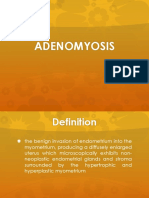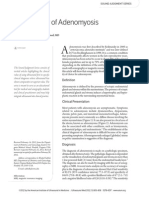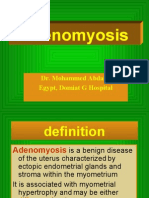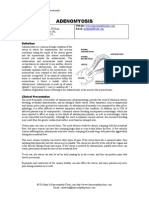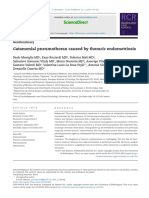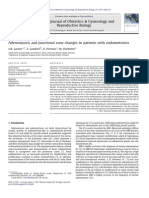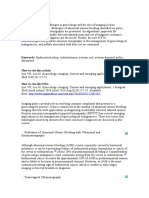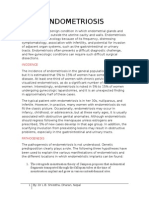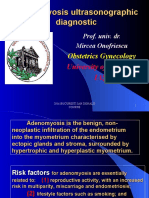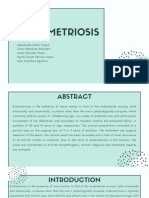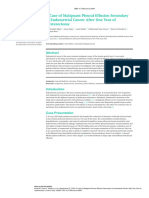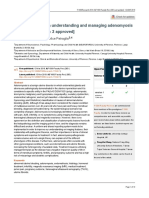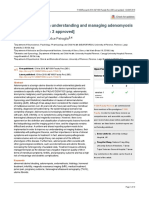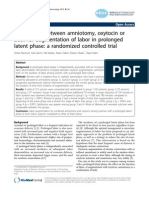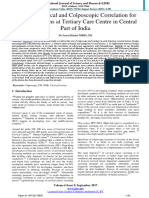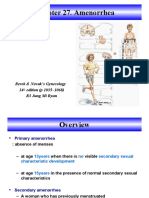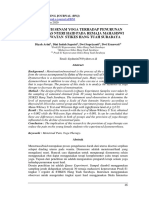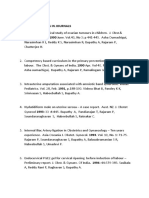3 s2.0 B9781437737943000013 3 PDF
3 s2.0 B9781437737943000013 3 PDF
Uploaded by
Aldo FerlyCopyright:
Available Formats
3 s2.0 B9781437737943000013 3 PDF
3 s2.0 B9781437737943000013 3 PDF
Uploaded by
Aldo FerlyOriginal Title
Copyright
Available Formats
Share this document
Did you find this document useful?
Is this content inappropriate?
Copyright:
Available Formats
3 s2.0 B9781437737943000013 3 PDF
3 s2.0 B9781437737943000013 3 PDF
Uploaded by
Aldo FerlyCopyright:
Available Formats
Section 1
Adenomyosis
Synonyms/Description
Endometriosis of the uterus or myometrium
Etiology
Adenomyosis is defined pathologically when
endometrial glands and stroma are found in the
myometrium, distant from the endometrial cavity itself. This ectopic endometrial tissue has the
ability to induce hypertrophy of the surrounding
myometrium. This process can be focal or diffuse
and thus accounts for the variability in the ultrasound appearances noted. The endometriummyometrium junctional zone is jagged and fuzzy
because the endometrial mucosa essentially
invades the underlying myometrium, thus blurring the interface between these two, typically
distinct zones. (This may be focal or global.)
outline of the endometrial cavity on 3-D coronal
view of the uterus.
Although magnetic resonance imaging (MRI)
has been useful for diagnosing adenomyosis, it is
unnecessary because ultrasound has similar
accuracy. A comparison between ultrasound and
MRI was reported using 23 articles (involving
2312 women). Transvaginal ultrasound had a
sensitivity and specificity of 72% and 81%,
respectively, whereas MRI had a sensitivity and
specificity of 77% and 89%, respectively.
Doppler evaluation of adenomyosis usually
does not add to the diagnosis because the
amount of vascularity is variable and
nonspecific.
Differential Diagnosis
The uterus is typically enlarged and globular
with heterogeneous myometrium, which is typically wider on one side than the other. The heterogeneous myometrium often contains
myometrial cysts, which likely represent areas of
glandular dilatation or hemorrhage caused by
repeated bleeding. These cysts are also frequently
seen in a subendometrial location.
If the area of adenomyosis is focal, it may be confused with a fibroid or a polyp if it projects into
the endometrial cavity. Because of the lucencies
and heterogeneities in the myometrium, uterine
malignancy (though very rare) is sometimes considered. The clue to the correct diagnosis is the
asymmetry of the width of the myometrium
comparing the posterior to the anterior aspect
on longitudinal view as well as the shaggy
appearance of the endometrial echo in a patient
with chronic pain and abnormal bleeding.
Adenomyoma
Clinical Aspects and Recommendations
An adenomyoma appears as a focal, somewhat
circumscribed island of heterogeneity in the
myometrium, suggesting a fibroid, but typically
without clear borders. When the borders are
sharp, one cannot distinguish an adenomyoma
from a fibroid. The adenomyoma may project
into the cavity in the form of a broad-based
polyp (polypoid adenomyoma).
Three-dimensional (3-D) ultrasound is helpful
to demonstrate the multitude of linear hyperechoic bands emanating from the endometrium
into the myometrium, producing the shaggy
Historically, heavy menstrual bleeding (menorrhagia) and painful menstruation (dysmenorrhea) are the major symptoms of adenomyosis
and are said to occur in approximately 60% and
25% of women, respectively. It has also been
implicated in some cases of chronic pelvic pain.
In the past, symptoms typically developed in
women in the fourth and fifth decade of life
(perimenopausally); however, this probably
reflects the fact that in the past the diagnosis of
adenomyosis historically was made at the time
of hysterectomy and not with sophisticated
Ultrasound Findings
Generalized Adenomyosis
3
Downloaded from ClinicalKey.com at Universitas Indonesia on February 29, 2016.
For personal use only. No other uses without permission. Copyright 2016. Elsevier Inc. All rights reserved.
Section 1
Adenomyosis
imaging techniques as are currently available. In
fact the obvious presence of endometrial glands
and stroma contained within the myometrium
in a large number of asymptomatic women
should cause clinicians to rethink whether adenomyosis is truly a disease or whether in some
cases it may be co-existing and not causal of the
patients symptoms. The exact percentage of
patients who will have classic findings of adenomyosis on sophisticated ultrasound studies and
yet be totally asymptomatic is unknown.
When present, the menorrhagia is probably
related to the increased endometrial surface area
of the enlarged uterus. Dysmenorrhea may be
caused by the cyclic bleeding and swelling of the
endometrial tissue confined within the
myometrium.
Definitive treatment for adenomyosis is hysterectomy. Because disease is confined to the
uterus, ovarian conservation can be considered
unless there are other reasons for their removal.
As there is no true plane separating the adenomyotic tissue from normal myometrium, surgical
excision as in myomectomy is not appropriate.
Various medical (nonsurgical) approaches have
been employed, including oral contraceptive
pills for treatment of the dysmenorrhea and
menorrhagia, progestin only therapy, and more
recently levonorgestrel-releasing intrauterine
devices (IUDs).
Figure A1-1 Two different patients. Typical appearance of the myometrium, which is asymmetric because of
adenomyosis. Note that the endometrial echo is closer to the anterior than the posterior wall of the uterus.
4
Downloaded from ClinicalKey.com at Universitas Indonesia on February 29, 2016.
For personal use only. No other uses without permission. Copyright 2016. Elsevier Inc. All rights reserved.
Section 1
Adenomyosis
Figure A1-2 Heterogeneous myometrium containing small echolucencies, typical of adenomyosis (two different
patients).
1
1
Figure A1-3 Adenomyoma projecting into the endometrial cavity from a broad base within the myometrium.
A shows the mass as ill-defined within the cavity, worrisome for a malignancy, especially in a postmenopausal patient.
B from the same patient shows the sonohysterogram with saline outlining the adenomyoma diagnosed by pathology.
5
Downloaded from ClinicalKey.com at Universitas Indonesia on February 29, 2016.
For personal use only. No other uses without permission. Copyright 2016. Elsevier Inc. All rights reserved.
Section 1
Adenomyosis
Figure A1-4 Three-dimensional ultrasound of two different patients with extensive adenomyosis. A shows the
reconstructed coronal view of the uterus with a fuzzy, ill-defined junction and linear echogenicities emanating out
from the edges of the endometrium. B shows a different patient with adenomyosis and a right-sided fibroid
demonstrating similar echolucencies. C (same patient as B) shows the inverse mode of the 3-D image that accentuates the lack of a clear border at the junction of the endometrium and myometrium.
6
Downloaded from ClinicalKey.com at Universitas Indonesia on February 29, 2016.
For personal use only. No other uses without permission. Copyright 2016. Elsevier Inc. All rights reserved.
Section 1
Adenomyosis
Suggested Reading
Bocca SM, Oehninger S, Stadtmauer L, Agard J,
Duran EH, Sarhan A, Horton S, Abuhamad AZ.
A study of the cost, accuracy, and benefits of
3-dimensional sonography compared with hysterosalpingography in women with uterine abnormalities. J Ultrasound Med. 2012;31:81-85.
Champaneria R, Abedin P, Daniels J, Balogun M,
Khan KS. Ultrasound scan and magnetic resonance
imaging for the diagnosis of adenomyosis: systematic review comparing test accuracy. Acta Obstet
Gynecol Scand. 2010;89:1374-1384.
Exacoustos C, Brienza L, Di Giovanni A, Szabolcs B,
Romanini ME, Zupi E, Arduini D. Adenomyosis
three-dimensional sonographic findings of the
junctional zone and correlation with histology.
Ultrasound Obstet Gynecol. 2011;37:471-479.
Maheshwari A, Gurunath S, Fatima F, Bhattacharya S.
Adenomyosis and subfertility: a systematic review
of prevalence, diagnosis, treatment and fertility
outcomes. Hum Reprod Update. 2012;18:374-392.
Valentini AL, Speca S, Gui B, Soglia G, Micc M,
Bonomo L. Adenomyosis: from the sign to the
diagnosis. Imaging, diagnostic pitfalls and differential diagnosis: a pictorial review. Radiol Med.
2011;116:1267-1287.
Wry O, Thille A, Gaspard U, van den Brule F. Adenomyosis: update on a frequent but difficult diagnosis.
J Gynecol Obstet Biol Reprod. 2005;34:633-648.
7
Downloaded from ClinicalKey.com at Universitas Indonesia on February 29, 2016.
For personal use only. No other uses without permission. Copyright 2016. Elsevier Inc. All rights reserved.
You might also like
- AdenomyosisDocument16 pagesAdenomyosisWiwik'RatnaSariPratiwi'100% (2)
- HysterectomyDocument25 pagesHysterectomyCreighton A. BayonganNo ratings yet
- Transvaginal Sonography and The Diagnosis of Adenomyosis: Col (DR) Hanifullah KhanDocument8 pagesTransvaginal Sonography and The Diagnosis of Adenomyosis: Col (DR) Hanifullah KhanJilleanneNo ratings yet
- Sonography of Adenomyosis: Sound Judgment SeriesDocument4 pagesSonography of Adenomyosis: Sound Judgment Seriesrolla_hiraNo ratings yet
- Adenomyosis Pictorial Essay of Two-Dimensional and Three-Dimensional Ultrasonography FindingsDocument5 pagesAdenomyosis Pictorial Essay of Two-Dimensional and Three-Dimensional Ultrasonography FindingsMarco Julcamoro AsencioNo ratings yet
- AdenomyosisDocument53 pagesAdenomyosisDr. mohammed50% (2)
- ADENOMYOSISDocument5 pagesADENOMYOSISdoddydrNo ratings yet
- AdenomyosisDocument53 pagesAdenomyosismadmax500No ratings yet
- Adenomiosis 2Document22 pagesAdenomiosis 2juan carlos pradaNo ratings yet
- The Pathophysiology of Uterine Adenomyosis: An UpdateDocument8 pagesThe Pathophysiology of Uterine Adenomyosis: An UpdateHarrison BungasaluNo ratings yet
- Fix Print DanisaDocument10 pagesFix Print DanisaDanisaNo ratings yet
- Review EndometriosisDocument23 pagesReview EndometriosisAline Costales TafoyaNo ratings yet
- AdenomyosisDocument0 pagesAdenomyosisWildan FirmansyahNo ratings yet
- ADENOMYOSISDocument16 pagesADENOMYOSISSneha GaneshNo ratings yet
- IETADocument10 pagesIETAJose Luis Morales BautistaNo ratings yet
- 10 1016@j Bpobgyn 2015 11 014Document17 pages10 1016@j Bpobgyn 2015 11 014Marco Julcamoro AsencioNo ratings yet
- Cea 9Document11 pagesCea 9Brenda Ruth PanjaitanNo ratings yet
- Ultrasound in Obstet Gyne - 2009 - Leone - Terms Definitions and Measurements To Describe The Sonographic Features ofDocument10 pagesUltrasound in Obstet Gyne - 2009 - Leone - Terms Definitions and Measurements To Describe The Sonographic Features ofDavid A Tovar ONo ratings yet
- Ultrasonographic Assessment of Ovarian Endometrioma: Journal of Medical Ultrasound December 2008Document9 pagesUltrasonographic Assessment of Ovarian Endometrioma: Journal of Medical Ultrasound December 2008muhhasanalbolkiah saidNo ratings yet
- Gynecology and Minimally Invasive Therapy: Ci Huang, Mun-Kun Hong, Dah-Ching DingDocument3 pagesGynecology and Minimally Invasive Therapy: Ci Huang, Mun-Kun Hong, Dah-Ching DingFhyno JuniorNo ratings yet
- Surgical Uterine-Sparing Management of Adenomyosis: Techniques and Review of LiteratureDocument10 pagesSurgical Uterine-Sparing Management of Adenomyosis: Techniques and Review of Literaturemiss betawiNo ratings yet
- Predictive Value of Ultrasound Imaging For Diagnosis and Surgery of Deep Endometriosis A Systematic ReviewDocument7 pagesPredictive Value of Ultrasound Imaging For Diagnosis and Surgery of Deep Endometriosis A Systematic Reviewdpgc79No ratings yet
- Uterine AdenomyosisDocument21 pagesUterine AdenomyosisBatch V Med 2 SY 21-22No ratings yet
- Piis0015028218305703 PDFDocument1 pagePiis0015028218305703 PDFPandawa ObgynNo ratings yet
- LI 1 AdenomyosisDocument4 pagesLI 1 AdenomyosisyasminNo ratings yet
- Catamenial Pneumothorax Caused by Thoracic Endometriosis: SciencedirectDocument5 pagesCatamenial Pneumothorax Caused by Thoracic Endometriosis: Sciencedirectk14m14No ratings yet
- Ad en Om Yo SisDocument6 pagesAd en Om Yo SisMariaa EndahhNo ratings yet
- Imaging Modalities in GynecologyDocument12 pagesImaging Modalities in GynecologyAngelia AngelNo ratings yet
- MWPUL0040EUC CWhite Endometriosis 01 2022 ES RZ X4Document16 pagesMWPUL0040EUC CWhite Endometriosis 01 2022 ES RZ X4sunindah1988No ratings yet
- Adenomyosis Fact SheetDocument4 pagesAdenomyosis Fact SheetAnonymous AZ2Z4FhV9zNo ratings yet
- Endometriosis at Caesarian Section Scar: Khalifa Al-JabriDocument2 pagesEndometriosis at Caesarian Section Scar: Khalifa Al-JabriJuan SetiajiNo ratings yet
- Imaging of Postoperative Endometrios - 2019 - Diagnostic and Interventional ImagDocument12 pagesImaging of Postoperative Endometrios - 2019 - Diagnostic and Interventional Imagsica_17_steaua6519No ratings yet
- Ahmed Ali - AdenomyosisDocument6 pagesAhmed Ali - AdenomyosisAhmed AliNo ratings yet
- SCHRAGER 2022 Adenomyosis Diagnosis and ManagementDocument6 pagesSCHRAGER 2022 Adenomyosis Diagnosis and ManagementCristiane HermesNo ratings yet
- Adenomiosis in PregDocument16 pagesAdenomiosis in Pregdr.elahe.babantaherNo ratings yet
- A Sonographic Sign of Moderate ToDocument5 pagesA Sonographic Sign of Moderate ToDivisi FER MalangNo ratings yet
- Keywords: Endometrial Polyp, Endometrioma, Ovarian Cyst, Ovarian Dermoid, PelvicDocument13 pagesKeywords: Endometrial Polyp, Endometrioma, Ovarian Cyst, Ovarian Dermoid, PelvicWarrodNo ratings yet
- EndometriosisDocument5 pagesEndometriosisLok100% (2)
- J SangeethaaDocument7 pagesJ Sangeethaavijay bNo ratings yet
- 1 s2.0 S2211568415003770 MainDocument7 pages1 s2.0 S2211568415003770 MainkarnelNo ratings yet
- 1 Adenomioza Bucuresti 2016 FINALDocument47 pages1 Adenomioza Bucuresti 2016 FINALDeea D.No ratings yet
- Adenomiose 2021Document6 pagesAdenomiose 2021mariajuliabechepecheNo ratings yet
- AdenomiosDocument7 pagesAdenomiosMauricio Ordaz RtkNo ratings yet
- EndometriosisDocument17 pagesEndometriosisIngrid HerreraNo ratings yet
- RM en endometriosis_frecuente pero escondido e infradiagnostticadaDocument14 pagesRM en endometriosis_frecuente pero escondido e infradiagnostticadaeldoctorsitociclistaNo ratings yet
- Journal SangeethaDocument7 pagesJournal Sangeethavijay bNo ratings yet
- Ultrasound in Obstet Gyne - 2015 - Van Den Bosch - Terms Definitions and Measurements To Describe Sonographic FeaturesDocument15 pagesUltrasound in Obstet Gyne - 2015 - Van Den Bosch - Terms Definitions and Measurements To Describe Sonographic FeaturesGiuliana Cuadros PeñalozaNo ratings yet
- A Case of Malignant Pleural Effusion Secondary To Endometrial Cancer After One Year of HysterectomyDocument5 pagesA Case of Malignant Pleural Effusion Secondary To Endometrial Cancer After One Year of HysterectomyPao Flores.No ratings yet
- MullerianDocument9 pagesMullerianMaurizio PasseraNo ratings yet
- Radiographics.19.Suppl 1.g99oc13s147Document14 pagesRadiographics.19.Suppl 1.g99oc13s147Diana PerezNo ratings yet
- Adenomyosis and Infertility - RBMDocument12 pagesAdenomyosis and Infertility - RBMRika EffendyNo ratings yet
- Disgerminom OvarianDocument7 pagesDisgerminom OvarianIfrim MihaelaNo ratings yet
- The Role of Hysteroscopy in The Diagnosis and Treatment of AdenomyosisDocument1 pageThe Role of Hysteroscopy in The Diagnosis and Treatment of AdenomyosisAnca Berescu StefanNo ratings yet
- UntitledDocument9 pagesUntitledOncología CdsNo ratings yet
- This Site Is Intended For Healthcare ProfessionalsDocument6 pagesThis Site Is Intended For Healthcare ProfessionalsAli RumiNo ratings yet
- Endometriosis. A Multimodal Imaging ReviewDocument14 pagesEndometriosis. A Multimodal Imaging Reviewradiologiang3No ratings yet
- Adeno Bun PDFDocument10 pagesAdeno Bun PDFtraciadrianaNo ratings yet
- Recent Advances in Understanding and Managing Adenomyosis.Document10 pagesRecent Advances in Understanding and Managing Adenomyosis.Luke O'DayNo ratings yet
- Submucous Myomas-Diagnosis and Therapy: (Dutch Society of Obstetrics and Gynaecology)Document12 pagesSubmucous Myomas-Diagnosis and Therapy: (Dutch Society of Obstetrics and Gynaecology)Titi SamalNo ratings yet
- How to Perform Ultrasonography in EndometriosisFrom EverandHow to Perform Ultrasonography in EndometriosisStefano GuerrieroNo ratings yet
- Syailendra Pendapatan Tetap PremiumDocument1 pageSyailendra Pendapatan Tetap PremiumAldo FerlyNo ratings yet
- PPARRs - CardiovascularDocument18 pagesPPARRs - CardiovascularAldo FerlyNo ratings yet
- Proofreading 3 Halaman CorrectionDocument9 pagesProofreading 3 Halaman CorrectionAldo FerlyNo ratings yet
- REZA Rerere SachDocument6 pagesREZA Rerere SachAldo FerlyNo ratings yet
- Night Shift Report 24-10-2014: Aldo Glenn SabrinaDocument16 pagesNight Shift Report 24-10-2014: Aldo Glenn SabrinaAldo FerlyNo ratings yet
- Personal Assignment Guidelines of Congestive Heart Failure in District HospitalDocument9 pagesPersonal Assignment Guidelines of Congestive Heart Failure in District HospitalAldo FerlyNo ratings yet
- Female Reproductive Cycle Ovulation Menstrual AtfDocument1 pageFemale Reproductive Cycle Ovulation Menstrual AtfAkeny AranyaNo ratings yet
- Checklist (PapSmear)Document11 pagesChecklist (PapSmear)VanDoctor JerseyNo ratings yet
- Abnormal Uterine Bleeding in AdolescentsDocument40 pagesAbnormal Uterine Bleeding in AdolescentsAyen FornollesNo ratings yet
- 2017 Pediatric Ovarian TorsionDocument13 pages2017 Pediatric Ovarian TorsionVladimir BasurtoNo ratings yet
- Family Planning MethodsDocument71 pagesFamily Planning MethodsFranklin Thomas100% (2)
- Gynae OncologyDocument52 pagesGynae OncologyrkNo ratings yet
- AmniotomiDocument8 pagesAmniotomibidan22No ratings yet
- Hysterosalpingogram (HSG) Patient Information, EDIDocument4 pagesHysterosalpingogram (HSG) Patient Information, EDItheanhphan218No ratings yet
- Holistic Menstrual Tracker - ThesyncwayDocument6 pagesHolistic Menstrual Tracker - ThesyncwayAamnah UnusNo ratings yet
- 2 Congenital AbnormalitiesDocument14 pages2 Congenital AbnormalitiesSamba SukanyaNo ratings yet
- Vulvovaginitis (POGS 2009)Document13 pagesVulvovaginitis (POGS 2009)JEREMIE FAYE UMALINo ratings yet
- ART20176809Document5 pagesART20176809dkhatri01No ratings yet
- Doctorwriting7 1531890392220Document3 pagesDoctorwriting7 1531890392220Haris Kalim YousafzaiNo ratings yet
- LEIOMYOMADocument14 pagesLEIOMYOMARANo ratings yet
- Analysis of Market Trends of Haematinics in KanpurDocument25 pagesAnalysis of Market Trends of Haematinics in KanpurJitendra Singh BundelaNo ratings yet
- Anoestrous in CattleDocument31 pagesAnoestrous in CattleDr. Anoop SinghNo ratings yet
- عهد ٥Document21 pagesعهد ٥Mohammad AlrefaiNo ratings yet
- History-Taking & Physical Examination by DR Samer Abu EidehDocument48 pagesHistory-Taking & Physical Examination by DR Samer Abu EidehAbdullah MatarNo ratings yet
- IudsDocument75 pagesIudssunielgowdaNo ratings yet
- Chapter 27. Amenorrhea: Berek & Novak's Gynecology 14 Edition (P 1035 1068) R3 Jung Mi ByunDocument95 pagesChapter 27. Amenorrhea: Berek & Novak's Gynecology 14 Edition (P 1035 1068) R3 Jung Mi Byunhossam626No ratings yet
- Pathology of The AdnexaDocument59 pagesPathology of The AdnexaArnella HutagalungNo ratings yet
- Acute Gynaecological Emergencies-1Document14 pagesAcute Gynaecological Emergencies-1Anivasa Kabir100% (1)
- Pengaruh Senam Yoga Terhadap Penurunan Intensitas Nyeri Haid Pada Remaja Mahasiswi Keperawatan Stikes Hang Tuah SurabayaDocument9 pagesPengaruh Senam Yoga Terhadap Penurunan Intensitas Nyeri Haid Pada Remaja Mahasiswi Keperawatan Stikes Hang Tuah SurabayaadiNo ratings yet
- Dr. A. Bupathy List of Publications in JournalsDocument6 pagesDr. A. Bupathy List of Publications in JournalsbupathyNo ratings yet
- Family Planning Methods - LatestDocument59 pagesFamily Planning Methods - LatestGenevieve VillaflorNo ratings yet
- Reproductive Health Class 12 Biology Mcqs PDF: Object 1Document41 pagesReproductive Health Class 12 Biology Mcqs PDF: Object 1rigNo ratings yet
- NCP EndometriosisDocument1 pageNCP EndometriosisDgjj Compuiter100% (1)
- Judul e BookDocument5 pagesJudul e Booksandi andiNo ratings yet
